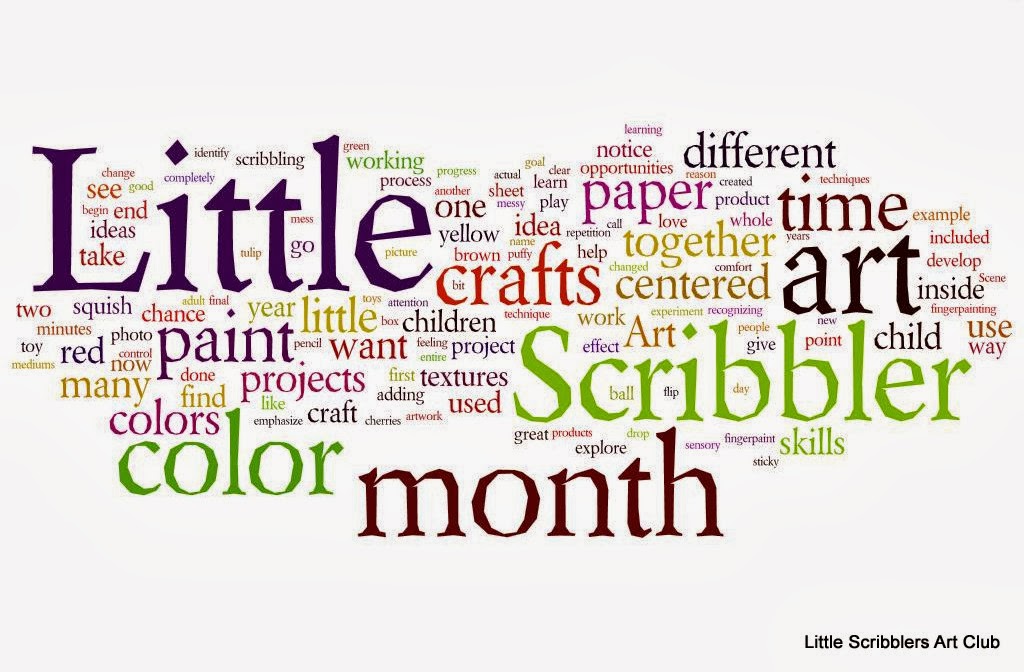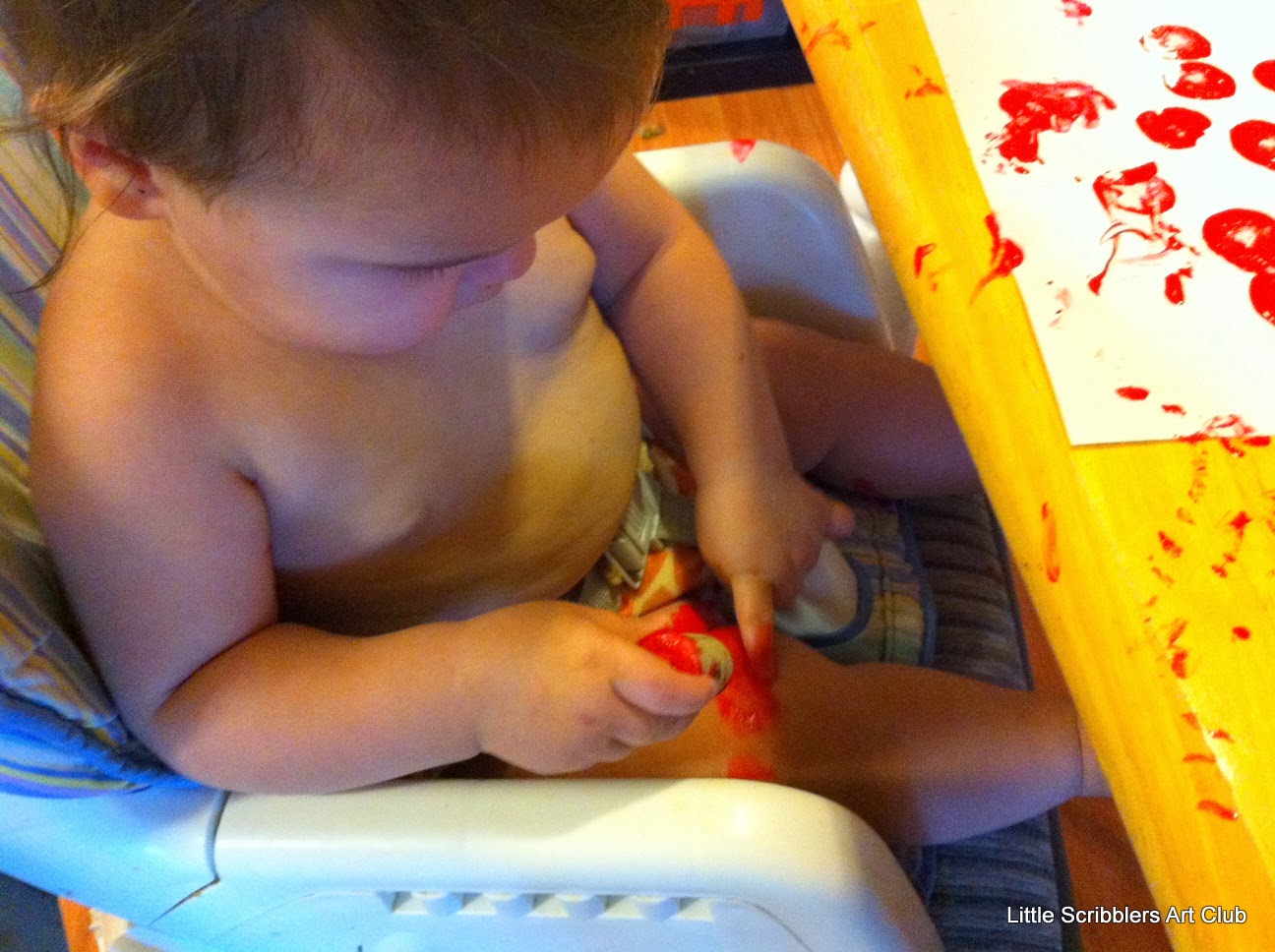"Mommy, it's a blue fish!"
"Yes, it is a blue fish; good job!"
The nurse was impressed; I was impressed; bystanders were impressed. "Do you work on colors with her?"
Granted, some of this is due to the fact that my child is and has always been in the lower percentiles on everything, so she looks pretty tiny to be able to articulate such an idea at her two-year-old well child visit (she probably looked 1 1/2). But it made me pause. "Well, we don't use flashcards with her or anything, if that's what you mean, but we read and talk a lot about colors." And there it is. The secret to teaching anything to a kid, right? Read about it. Use it in your daily language. Not only do we talk about colors during art time, we do it while waiting in restaurants, driving, and getting dressed. We didn't set out to teach her colors, it was something she was naturally curious about. And that's important, too. Don't force the issue with anything you're trying to teach a kid (words of advice I could've used at work today).
In our color journey, we have discovered some books that have been really helpful and not too painful to read over and over again.
~The Classics~
 Put Me in the Zoo by Robert Lopshire: We used the board book version of this one (the other version is much longer and not as focused on the colors). This book uses the colors blue, orange, green, and violet in that order to describe the animal's spots. It has good repetition of short words and a rhyming pattern. Each page is a short 3-4 lines of text. Great for the attention span of a Little Scribbler.
Put Me in the Zoo by Robert Lopshire: We used the board book version of this one (the other version is much longer and not as focused on the colors). This book uses the colors blue, orange, green, and violet in that order to describe the animal's spots. It has good repetition of short words and a rhyming pattern. Each page is a short 3-4 lines of text. Great for the attention span of a Little Scribbler.
 Brown Bear, Brown Bear, What Do You See? by Bill Martin Jr: Pattern books become the first books your child "reads" by himself or herself. They get the idea that particular books "say" the same thing every time and once they've memorized it, they "read" through as if they know the sounds. If you don't love this series, please, please, please find another pattern book you can get through with your little ones (says the reading teacher in me). This book uses the colors brown, red, yellow, blue, green, purple, white, black, and gold. This is also a great book to use for teaching animal sounds. As your Little Scribbler gets older, you can flip to the next page and have him or her fill in the blanks: I see a _____ ______ looking at me. Even later still, your little one will probably know what comes next before you turn the page. The last page is a great review of all of the colors in one place.
Brown Bear, Brown Bear, What Do You See? by Bill Martin Jr: Pattern books become the first books your child "reads" by himself or herself. They get the idea that particular books "say" the same thing every time and once they've memorized it, they "read" through as if they know the sounds. If you don't love this series, please, please, please find another pattern book you can get through with your little ones (says the reading teacher in me). This book uses the colors brown, red, yellow, blue, green, purple, white, black, and gold. This is also a great book to use for teaching animal sounds. As your Little Scribbler gets older, you can flip to the next page and have him or her fill in the blanks: I see a _____ ______ looking at me. Even later still, your little one will probably know what comes next before you turn the page. The last page is a great review of all of the colors in one place.
~Bilingual Books~
My Colors, My World; Mis colores, mi mundo by Maya Christina Gonzalez: This board book is another adaptation of a longer, larger book. Since we use two languages in our household, my husband reads this book to her in English and I read it to her in Spanish. This book uses the colors brown, orange, purple, yellow, green, red, black, and pink. (En español: marrón, anaranjado, violeta, amarillo, verde, rojo, negro, y rosado.) It's probably a little confusing for her because we use a different word for purple (morado) than the book uses. The language (no matter if it's English or Spanish) is exquisitely descriptive while being concise, "The night falls, velvety blue."

There are a whole series of these books, and even one dedicated to color. While some of the words in this particular book are pretty effectively communicated, I wouldn't say the same about the color page. Bilingual books can be really good, or kind of "meh." Some of the pictures didn't really even look familiar to us, so it was hard to connect the words to the concepts. Maybe the actual color book would be better, but I would pass on this one.
~Interactive Books~
My Very First Book of Colors by Eric Carle: This book is split with a top half and a bottom half throughout the whole book. It uses the colors blue, white, green, pink, many colors, red, yellow, black, purple, and brown. Almost the same colors we use in Little Scribblers Art Club. The word for the color is on the left top, a swab of paint that matches the word is on the top right, and the bottom has artwork that is primarily made from one of the colors, but in random order. For older kiddos, the idea would be to match the color to the word on their own. For our own Little Scribbler, we flipped through each page and asked, "Is this blue (or whatever color)?" Flipping the bottom page until we found the match.

Color Train, Color Train! by Martin Kelly: This book comes in two formats, the one pictured (which is called "square"), and another that measures 6 1/4" x 12" and opens from the top (called "portrait"). The cool thing about this book is the pull through ribbons (6 total) that magically appear each time you turn the page (although an eager little one can pull too hard and with the resistance of the ribbon it is easy to bend the board book). I am not a fan of whimsical artwork, nor poetry that doesn't quite have the right rhythm. However, the focus of each color page, the movement of the plot (if it can be called that) at the end as the train goes through a tunnel and into the train yard, and the super-cool ribbons override any perceived negatives. This book uses the colors blue, purple, green, yellow, orange, red, and black and reinforces them all again at the end.

Fuzzy Yellow Ducklings by Matthew Van Fleet: Books by this author are simply amazing! I haven't come across a single one that didn't draw me in as much as (or sometimes even more than) my daughter. This one is not a board book (although it is a thicker cardstock), so we keep this one out of reach for now and enjoy it together so that our investment is protected. :) These book are generally twice what you would pay for others, but as it says on the back of each book: they are painstakingly hand crafted. The words in this book are so simple and yet seemingly calculated to get the biggest bang for your buck as far as the concept a child learns with each turn. Each page has a texture word, a color word, a shape, and an animal word under each flap. For example, the first page reads "Fuzzy Yellow Circle," and then when you open the flap the picture changes and the word "Ducklings" appears to create a new description: "Fuzzy Yellow Ducklings." The flaps are the most fragile part of the books, but ours has survived so far with just a few creases. The pages also have touch and feel sections built in to reinforce the texture words used: fuzzy, bumpy, furry, scaly, woolly, scratchy, and sticky (our favorite). This book uses the colors yellow, brown, gray, green, white, blue, and pink.

Scholastic's Eyelike Series- Colors: The rainbow of the natural world: I've saved the best for last. This book focuses on colors in the natural world and the photos are unbelievably vibrant. This is not a board book or even cardstock, although there are Baby Eyelike board books now, too. It is more similar to a heavy catalog page, so it's really not meant for Little Scribblers to use on their own, but we've been looking at it together since my little one was probably 6 months old. The one drawback for me is the rhythm of the writing, but that's probably just my preference. There are 32 full color spreads that give multiple examples of real world things that are yellow, red, green, brown, tan, blue, orange, purple, transparent, translucent, iridescent, pink, gray, black, white, black and white (yes, another category), two-tone, and multicolor. The labels are high level vocabulary (you won't find flower, but you will find daffodil, poppy, iris, pansy, and edelweiss), and give you even more choices of words to use when talking about the pictures. Many of the pages name different hues of the colors, as well. This has been a favorite and an inspiration for me when I began to develop Little Scribblers Art Club. We will definitely be looking for others (shapes & patterns, opposites, numbers, and letters) in the series soon!
I'm not a huge proponent of connecting everything from literature to art, but art time has definitely given us time to solidify the concept of color we'd been reading about while practicing other beneficial skills. As I said before, reading about and talking about colors is a major part of this teaching thing, but I guess I would say that it just isn't complete until you have experienced it, too (no matter what the "it" is in that sentence). Throughout our first year of art together, once I got up the nerve to plunge in, I focused on one color at a time. I didn't realize until later that I was naturally using Montessori's principle of isolation. By using just one color as a focus, it simplifies the conceptual input for the child. Try it yourself; different hues of the same color set up ahead of time for your Little Scribbler to use. An easy way to develop color concept!
For those do-it-yourselfers out there, check out our Pinterest page for color themed art appropriate for this stage of development to enhance your child's experience with colors. And of course, I'd like to plug our upcoming release of a color-focused year-long art club subscription for toddlers, twos, and children with special needs, but I'd also like to encourage the use of color books and art time no matter what!
I have definitely found other color books that I would add to a wishlist! What books have you used to teach a Little Scribbler about color?
Pin It Now!









































